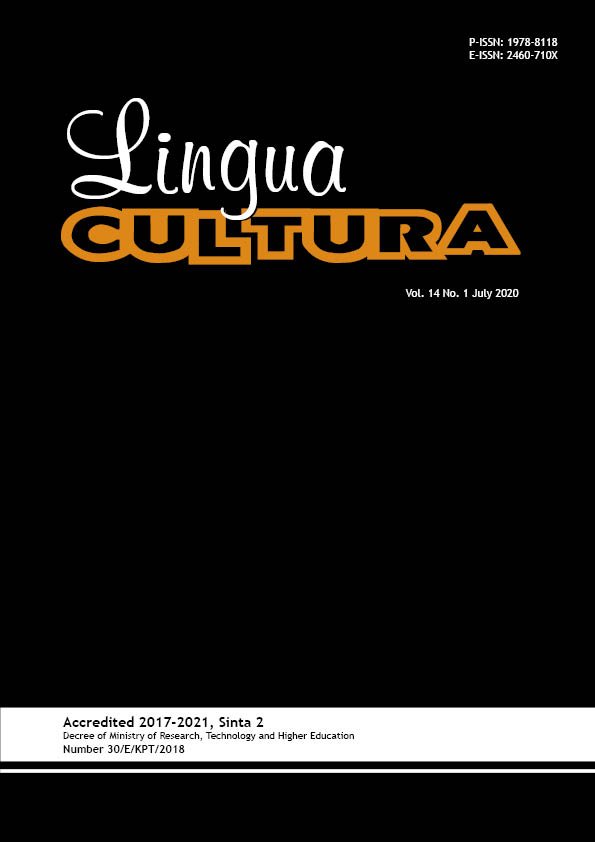The Impact of Translation Method and Shift on Translation Quality at Bilingual Textbooks of Physics, Mathematics and History
DOI:
https://doi.org/10.21512/lc.v14i1.6387Keywords:
translation method, translation shift, translation qualityAbstract
The first goal of the research was to figure out translation methods and shifts applied in translating bilingual textbooks of History, Mathematics, and Physics, Those bilingual textbooks were published by Quadra, Yramawidia, and Yudhisthira, used for grade seven in Medan. The second was to figure out the impact of translation methods and shifts which dominant on translation quality. The third was to recommend better bilingual textbooks to use based on the translation quality point of view. The research used a descriptive qualitative research method with a questionnaire, depth-interview, and observation on a pair of translation to collect the data. The data were analyzed with interactively and non-interactively. Based on the data analysis, the research finds that (1) the dominant shift on History textbook is unit shift while the dominant method is a free translation, the dominant shift on Physics is a unit shift and dominant method is a communicative translation, the dominant shift on Mathematics is structure shift and dominant method is communicative translation. The second finding is that the impact of the dominant translation shift and method on the History textbook is negative. At the same time, in Mathematics and Physics are positive. Third, the research; the researcher recommends bilingual textbooks of Mathematics and Physics to use based on translation quality point of view. The well bilingual textbooks can improve students’ language skills, while low translation quality influences bad development to students on learning the language.
References
Al Farisi (2018). The impact of techniques and translation ideology on the clarity of pragmatic meanings translation of the quranic imperative verses. Indonesian Journal of Applied Linguistics, 7(3), 676-686. https://doi.org/10.17509/ijal.v7i3.9818.
Ardi, H. (2017). The impact of translation techniques toward the quality of translation: A case study on a social text. Humanus, 15(2), 142-153. https://doi.org/10.24036/jh.v15i2.6564.
Ayyad, G. R., & Mahadi, T. S. T. (2019). Strategies of Translating Qur’Anic Cultural Terms. International Journal of Humanities, Philosophy, and Language, 2(7), 139-147. https://doi.org/10.35631/ijhpl.270012.
Catford, J. C. (1978). A linguistic theory of translation. London: Oxford University Press.
Hidayat, A., & Harmoko, D. D. (2018). Translation method and procedures in bilingual storybooks. Scope: Journal of English Language Teaching, 2(2), 112-122. http://dx.doi.org/10.30998/scope.v2i02.2414.
Mafulah, S., Wilujeng, T. T. R., Lutviana, R., Hariyanto, S., Purnawati, M., & Rahutomo, F. (2018). CAT tool on teaching translation for EFL students. International Journal of Engineering & Technology, 7(3.5), 98-100.
Miles, M. B., Huberman, M., & Saldana, J. (2014). Qualitative data analysis. California: SAGE Publication. Inc.
Muchtar, M., & Kembaren, F. R. W. (2018). Translation techniques and quality in the english version of nganting manuk text. IJLRES: International Journal on Language Research and Education Studies, 2(2), 195-207.
Nababan, M., Nuraeni, A., & Sumardiono. (2012). Pengembangan model penilaian kualitas terjemahan. Kajian Linguistik dan Sastra, 24(1), 39-57.
Nababan, H., Nababan, M. R., & Santosa, R. (2019). Translation techniques and their impact on the readability of translated bible stories for children. Humanus; Jurnal Ilmiah Ilmu-Ilmu Humaniora, 17(2), 212-222. https://doi.org/10.24036/humanus.v17i2.102729.
Newmark, P. (1988). Textbook of translation. Oxford: Pegamon Press.
Nurlaila., Nababan, M., Djatmika., & Santosa, R. (2018). Translation issues in the children comic ‘donald duck’. International Journal of Engineering & Technology, 7(3.21), 389-394. https://doi.org/10.14419/ijet.v7i3.21.17198.
Rini, Y. P. (2015). Analysis of the category shift of noun phrases in translation of the queen swallow’s gift. Jurnal Tadris Bahasa Inggris IAIN Raden Intan, 7(1), 131-148. https://doi.org/10.24042/ee-jtbi.v7i1.437.
Romdhati, A. T., Nababan, M., & Santosa, R (2018). Translation techniques and their impacts to the modality orientation’s shift in ‘the jungle book’ movie subtitle. Lingua Cultura, 12(4), 375-381. https://doi.org/10.7202/008033a.
Sipayung, K. T. (2018). The impact of translation shift and method on translation accuracy found at bilingual History textbook. Humaniora, 30(1), 58-66. https://doi.org/10.22146/jh.27754.
Siregar, M., Sinar, T. S., Saragih, A., & Lubis, S. (2018). Need analysis for developing translation’s textbook base on TEFL pedagogical purpose in Indonesia: English teachers perspectives. Advances in Language and Literary Studies, 9(3), 81-86. https://doi.org/10.7575/aiac.alls.v.9n.3p.81.
Sofyan, R., & Tarigan, B. (2019). Developing a Holistic Model of Translation Quality Assessment. Advances in Social Science, Education and Humanities Research, 254, 266-271. https://doi.org/10.2991/conaplin-18.2019.267.
Yulianta, N. G., Nababan, M., & Djatmika. (2018). The acceptability of religious terms translation in the complete idiot’s guide to understanding Islam. Lingua Cultura, 12(2), 111-115. https://doi.org/10.21512/lc.v12i2.3999.
Wahyuni, R., Gurning, B., & Sinar, T. S. (2015). Coherence and cohesion shift in the students’ translated text. Jurnal Linguistik Terapan Pascasarjana Unimed, 12(2), 138-145. https://doi.org/10.24114/lt.v12i2.2921.
Wang, J. S. (2017). Translation quality assessment: Bridge the gap between theory and practice. Journal of Literature and Art Studies, 7(10), 1701-1706. https://doi.org/10.17265/2159-5836/2017.10.023.
Downloads
Published
How to Cite
Issue
Section
License
Copyright (c) 2020 Lingua Cultura

This work is licensed under a Creative Commons Attribution-ShareAlike 4.0 International License.
Authors who publish with this journal agree to the following terms:
a. Authors retain copyright and grant the journal right of first publication with the work simultaneously licensed under a Creative Commons Attribution License - Share Alike that allows others to share the work with an acknowledgment of the work's authorship and initial publication in this journal.
b. Authors are able to enter into separate, additional contractual arrangements for the non-exclusive distribution of the journal's published version of the work (e.g., post it to an institutional repository or publish it in a book), with an acknowledgment of its initial publication in this journal.
c. Authors are permitted and encouraged to post their work online (e.g., in institutional repositories or on their website) prior to and during the submission process, as it can lead to productive exchanges, as well as earlier and greater citation of published work.
USER RIGHTS
All articles published Open Access will be immediately and permanently free for everyone to read and download. We are continuously working with our author communities to select the best choice of license options, currently being defined for this journal as follows: Creative Commons Attribution-Share Alike (CC BY-SA)


















